
The Lindisfarne Gospels is an illuminated manuscript gospel book probably produced around the years 715–720 in the monastery at Lindisfarne, off the coast of Northumberland, which is now in the British Library in London. The manuscript is one of the finest works in the unique style of Hiberno-Saxon or Insular art, combining Mediterranean, Anglo-Saxon and Celtic elements.

The Book of Kells is an illuminated manuscript Gospel book in Latin, containing the four Gospels of the New Testament together with various prefatory texts and tables. It was created in a Columban monastery in either Ireland, Scotland or England, and may have had contributions from various Columban institutions from each of these areas. It is believed to have been created c. 800 AD. The text of the Gospels is largely drawn from the Vulgate, although it also includes several passages drawn from the earlier versions of the Bible known as the Vetus Latina. It is a masterwork of Western calligraphy and represents the pinnacle of Insular illumination. The manuscript takes its name from the Abbey of Kells, County Meath, which was its home for centuries.

The Book of Durrow is an illuminated manuscript dated to c. 700 that consists of text from the four Gospels gospel books, written in an Irish adaption of Vulgate Latin, and illustrated in the Insular script style.

Codex Usserianus Primus is an early 7th-century Old Latin Gospel Book. It is dated palaeographically to the 6th or 7th century. It is designated by r.

The Book of Cerne is an early ninth-century Insular or Anglo-Saxon Latin personal prayer book with Old English components. It belongs to a group of four such early prayer books, the others being the Royal Prayerbook, the Harleian prayerbook, and the Book of Nunnaminster. It is now commonly believed to have been produced sometime between ca. 820 and 840 AD in the Southumbrian/Mercian region of England. The original book contains a collection of several different texts, including New Testament Gospel excerpts, a selection of prayers and hymns with a version of the Lorica of Laidcenn, an abbreviated or Breviate Psalter, and a text of the Harrowing of Hell liturgical drama, which were combined to provide a source used for private devotion and contemplation. Based on stylistic and palaeographical features, the Book of Cerne has been included within the Canterbury or Tiberius group of manuscripts that were manufactured in southern England in the 8th and 9th centuries AD associated with the Mercian hegemony in Anglo-Saxon England. This Anglo-Saxon manuscript is considered to be the most sophisticated and elaborate of this group. The Book of Cerne exhibits various Irish/Celtic, Anglo-Saxon, Continental, and Mediterranean influences in its texts, ornamentation, and embellishment.

The Hereford Gospels is an 8th-century illuminated manuscript gospel book in insular script (minuscule), with large illuminated initials in the Insular style. This is a very late Anglo-Saxon gospel book, which shares a distinctive style with the Caligula Troper. An added text suggests this was in the diocese of Hereford in the 11th century.
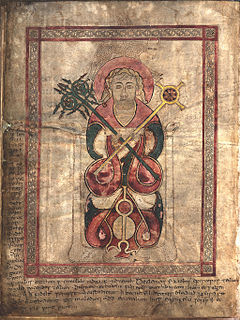
The Lichfield Gospels is an 8th-century Insular Gospel Book housed in Lichfield Cathedral. There are 236 surviving pages, eight of which are illuminated. Another four contain framed text. The pages measure 30.8 cm by 23.5 cm. The manuscript is also important because it includes, as marginalia, some of the earliest known examples of written Old Welsh, dating to the early part of the 8th century. Peter Lord dates the book at 730, placing it chronologically before the Book of Kells but after the Lindisfarne Gospels.

The St Augustine Gospels is an illuminated Gospel Book which dates from the 6th century. It was made in Italy and has been in England since fairly soon after its creation; by the 16th century it had probably already been at Canterbury for almost a thousand years. It has 265 leaves measuring about 252 x 196 mm, and is not entirely complete, in particular missing pages with miniatures.
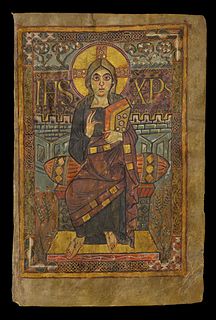
The Godescalc Evangelistary, Godescalc Sacramentary, Godescalc Gospels, or Godescalc Gospel Lectionary is an illuminated manuscript in Latin made by the Frankish scribe Godescalc and today kept in the Bibliothèque nationale de France. It was commissioned by the Carolingian king Charlemagne and his wife Hildegard on October 7, 781 and completed on April 30, 783. The Evangelistary is the earliest known manuscript produced at the scriptorium in Charlemagne's Court School in Aachen. The manuscript was intended to commemorate Charlemagne's march to Italy, his meeting with Pope Adrian I, and the baptism of his son Pepin. The crediting of the work to Godescalc and the details of Charlemagne's march are contained in the manuscript's dedication poem.
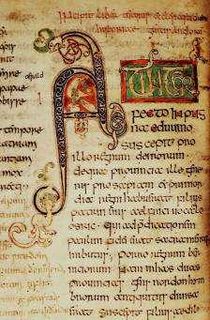
British Library, MS Cotton Tiberius C. II, or the Tiberius Bede, is an 8th-century illuminated manuscript of Bede's Historia ecclesiastica gentis Anglorum. It is one of only four surviving 8th-century manuscripts of Bede, another of which happens to be MS Cotton Tiberius A. XIV, produced at Monkwearmouth–Jarrow Abbey. As such it is one of the closest texts to Bede's autograph. The manuscript has 155 vellum folios. This manuscript may have been the Latin text on which the Alfredian Old English translation of Bede's Ecclesiastical History was based. The manuscript is decorated with zoomorphic initials in a partly Insular and partly Continental style.

The Vespasian Psalter is an Anglo-Saxon illuminated psalter decorated in a partly Insular style produced in the second or third quarter of the 8th century. It contains an interlinear gloss in Old English which is the oldest extant English translation of any portion of the Bible. It was produced in southern England, perhaps in St. Augustine's Abbey or Christ Church, Canterbury or Minster-in-Thanet, and is the earliest illuminated manuscript produced in "Southumbria" to survive.
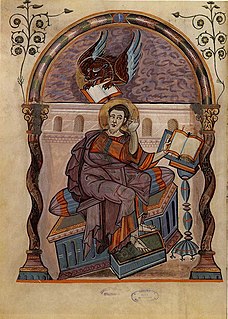
Evangelist portraits are a specific type of miniature included in ancient and mediaeval illuminated manuscript Gospel Books, and later in Bibles and other books, as well as other media. Each Gospel of the Four Evangelists, the books of Matthew, Mark, Luke, and John, may be prefaced by a portrait of the Evangelist, usually occupying a full page. Their symbols may be shown with them, or separately. Often they are the only figurative illumination in the manuscript. They are a common feature in larger Gospel Books from the earliest examples in the 6th century until the decline of that format for illustrated books in the High Middle Ages, by which time their conventions were being used for portraits of other authors.

Anglo-Saxon art covers art produced within the Anglo-Saxon period of English history, beginning with the Migration period style that the Anglo-Saxons brought with them from the continent in the 5th century, and ending in 1066 with the Norman Conquest of England, whose sophisticated art was influential in much of northern Europe. The two periods of outstanding achievement were the 7th and 8th centuries, with the metalwork and jewellery from Sutton Hoo and a series of magnificent illuminated manuscripts, and the final period after about 950, when there was a revival of English culture after the end of the Viking invasions. By the time of the Conquest the move to the Romanesque style is nearly complete. The important artistic centres, in so far as these can be established, were concentrated in the extremities of England, in Northumbria, especially in the early period, and Wessex and Kent near the south coast.
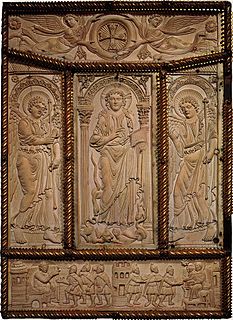
Carolingian art comes from the Frankish Empire in the period of roughly 120 years from about 780 to 900—during the reign of Charlemagne and his immediate heirs—popularly known as the Carolingian Renaissance. The art was produced by and for the court circle and a group of important monasteries under Imperial patronage; survivals from outside this charmed circle show a considerable drop in quality of workmanship and sophistication of design. The art was produced in several centres in what are now France, Germany, Austria, northern Italy and the Low Countries, and received considerable influence, via continental mission centres, from the Insular art of the British Isles, as well as a number of Byzantine artists who appear to have been resident in Carolingian centres.

A carpet page is a full page in an illuminated manuscript containing intricate, non-figurative, patterned designs. They are a characteristic feature of Insular manuscripts, and typically placed at the beginning of a Gospel Book. Carpet pages are characterised by mainly geometrical ornamentation which may include repeated animal forms. They are distinct from pages devoted to highly decorated historiated initials, though the style of decoration may be very similar.

Insular art, also known as Hiberno-Saxon art, was produced in the post-Roman era of the British Isles. The term derives from insula, the Latin term for "island"; in this period Britain and Ireland shared a largely common style different from that of the rest of Europe. Art historians usually group insular art as part of the Migration Period art movement as well as Early Medieval Western art, and it is the combination of these two traditions that gives the style its special character.
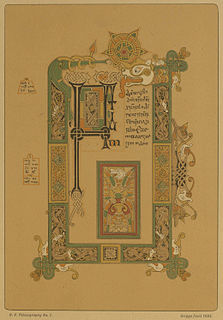
The Mac Durnan Gospels or Book of Mac Durnan is an illuminated manuscript Gospel book made in Ireland in the 9th or 10th century, a rather late example of Insular art. Unusually, it was in Anglo-Saxon England soon after it was written, and is now in the collection of Lambeth Palace Library in London.

The Lindau Gospels is an illuminated manuscript in the Morgan Library in New York, which is important for its illuminated text, but still more so for its treasure binding, or metalwork covers, which are of different periods. The oldest element of the book is what is now the back cover, which was probably produced in the later 8th century in modern Austria, but in the context of missionary settlements from Britain or Ireland, as the style is that of the Insular art of the British Isles. The upper cover is late Carolingian work of about 880, and the text of the gospel book itself was written and decorated at the Abbey of Saint Gall around the same time, or slightly later.

Insular illumination refers to the production of illuminated manuscripts in the monasteries of Ireland and Great Britain between the 6th and 9th centuries, as well as in monasteries under their influence on continental Europe. It is characterised by decoration strongly influenced by metalwork, the constant use of interlacing, and the importance assigned to calligraphy. The most celebrated books of this sort are largely gospel books. Around sixty manuscripts are known from this period.

The Emperor's Bible, also known as Codex Caesareus, Codex Caesareus Upsaliensis or the Goslar Gospels, is an 11th-century illuminated manuscript currently in Uppsala University Library, Sweden. Despite its name, it is not a Bible but a Gospel Book. The book was made in the scriptorium of Echternach Abbey, and is one of four preserved large Gospel Books made there during the 11th century. It was commissioned by Emperor Henry III and donated by him to Goslar Cathedral, where it remained until the Thirty Years' War. It was then lost for about 100 years. Its previous richly decorated cover was also lost at this time at the latest. The book later appeared again in the possession of Swedish diplomat and civil servant Gustaf Celsing the Elder. At the death of his son, it was acquired by Uppsala University.





















